Introduction
Hardware Labs Black Ice® SR2 240 MP Radiator Review
Since we published the most recent of the 360mm radiators for inclusion in the Extreme Rigs Rad Round Up 2015, we’ve kept busy conducting more radiator testing. However samples from various sponsors were arriving at different times and contained different sized radiators leaving us with a somewhat random collection of new data. Given that we strive to publish quality data driven reviews, we thought it better to hold off posting data on a single radiator in a certain size until we could compare it with test results from a same sized radiator.
The wait is over and with continued support from two of our regular sponsors, we can now publish reviews on what we believe will be 2 of the most popular 240mm radiators released this year.
In this review we’ll be taking a close look at the SR2 240 MP from Hardware Labs. We took a look a pre-production sample of the 360mm version for the round-up, so if the 360mm size is more your flavor be sure to check out it’s full review after you’re finished reading this one. We have wanted to check out the performance comparisons between radiator sizes, so in this review we’ll also compare some of the 240mm data vs. it’s 360mm sibling as well as results from the other 240mm radiator that we currently have.
Firstly a big thanks to Hardware Labs for providing the review sample of the SR2 240 MP!
What’s in the Box?
The SR2 240 MP sample arrived in full retail packaging. Existing packaging from the SR2 240 has been used, as the “MP MuiltiPort” labelling is a sticker which has been strategically placed on the front of the retail sleeve.
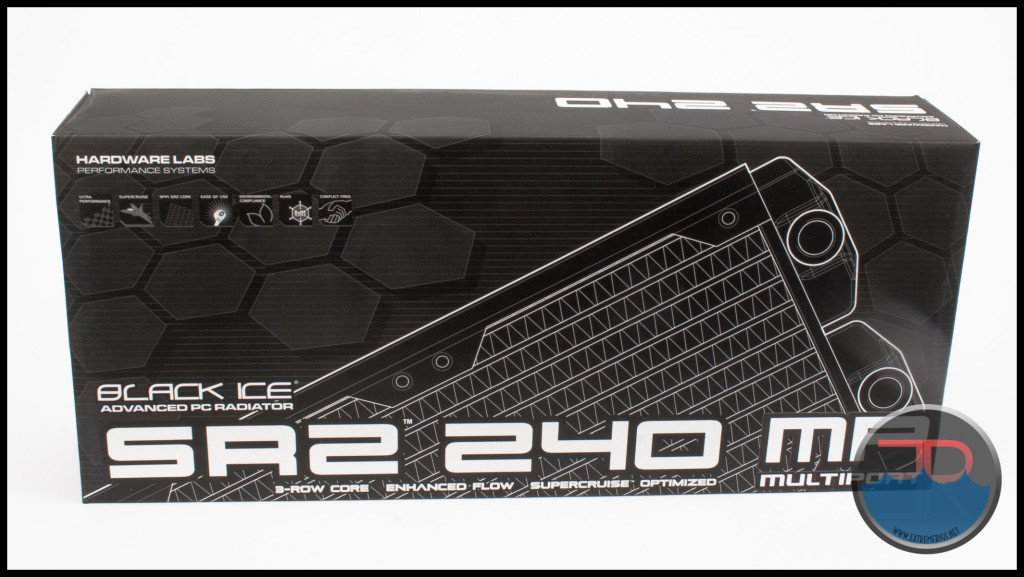 The front of the retail sleeve leaves us in no doubt as to what to expect, while on the back we find a tech drawing and some details on the SR2 240 radiator.
The front of the retail sleeve leaves us in no doubt as to what to expect, while on the back we find a tech drawing and some details on the SR2 240 radiator.
Note in the last sentence I said simply the SR2 240, and together with the sticker placement on the front, we conclude that the SR2 240 MP has exactly the same cooling package (core) as the single port version. HWLabs has confirmed this is correct, and the extra ports are the only changes in the MP version.
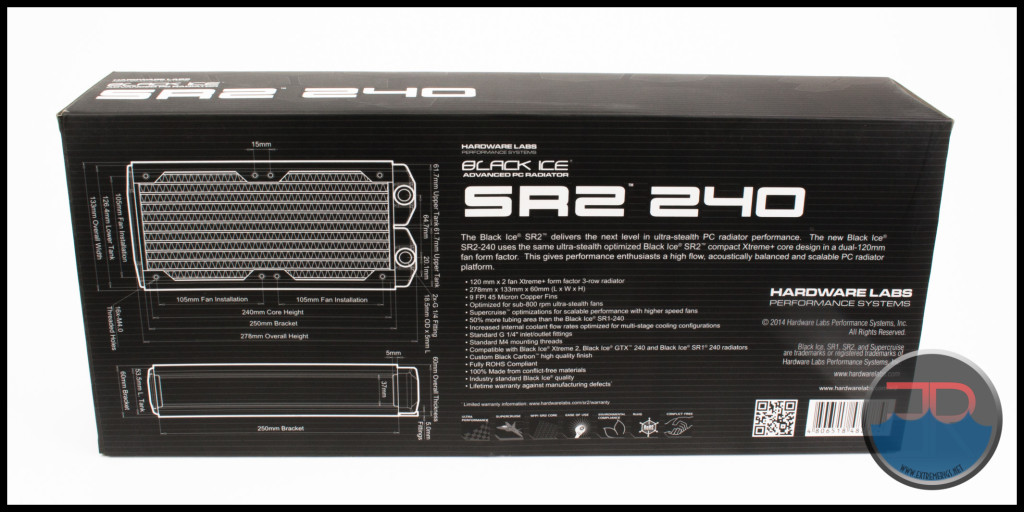 On one side we find some performance ratings on the various SR2 models.
On one side we find some performance ratings on the various SR2 models.
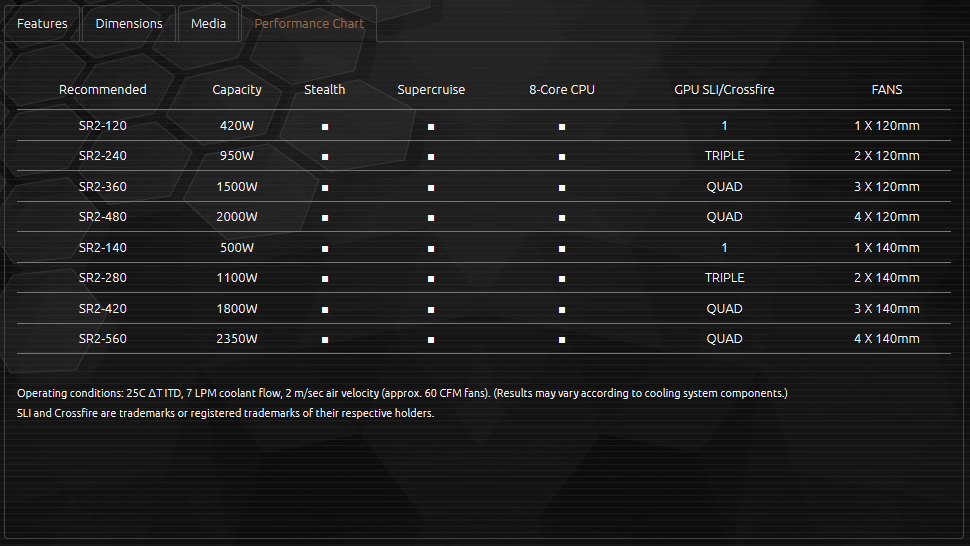
While we have no doubt the 950W result for the SR2 240 is valid for such a high delta, we really dislike the standardized test conditions used for this. While it may be useful for OEMs/vendors to compare it can be confusing for water cooling users as we generally like much lower temperature deltas.
Inside the outer retail sleeve is a protective cardboard box. The adhesive used to assemble the retail sleeve always seems to make it’s way onto the inner box making them extremely difficult to remove most of the time. This one ended up tearing:
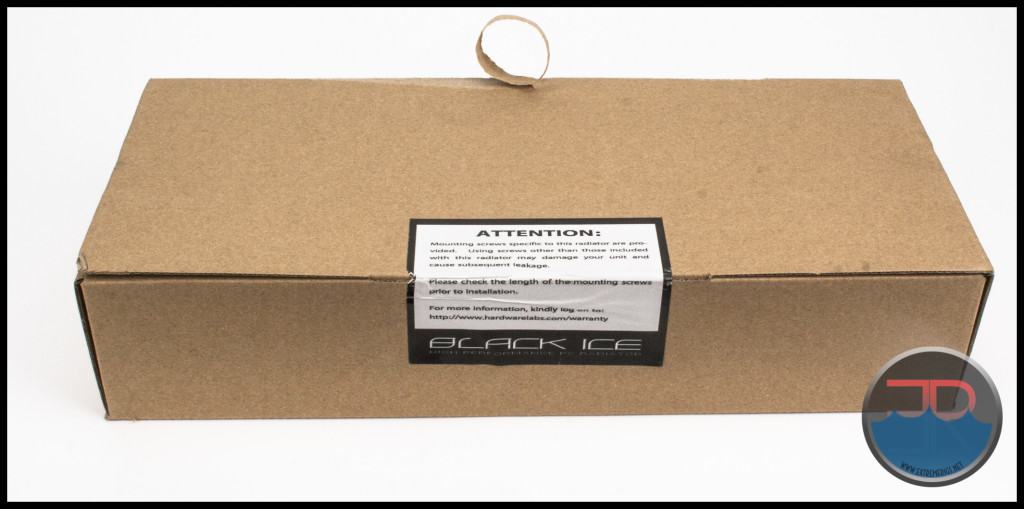 That small complaint aside, I really like the HWLabs style of boxing as the compartment at one end keeps the provided accessories away from the core. It would be nice to see a bubble wrap sleeve over the rad, but otherwise the SR2 MP has great packaging that should ensure safe arrival to the end user.
That small complaint aside, I really like the HWLabs style of boxing as the compartment at one end keeps the provided accessories away from the core. It would be nice to see a bubble wrap sleeve over the rad, but otherwise the SR2 MP has great packaging that should ensure safe arrival to the end user.
Under the flap on the right hand side, we found 3 bags with the supplied accessories.
Extent of delivery:
Included in the SR2 240 MP package is the following:
1 x SR2 Multi-Port Radiator
8 x M4 x 28mm screw s for mounting fans.
8 x M4 x 5mm screws for attaching to chassis
4 x G 1/4 port plugs.
Note that the 28mm screws are only just long enough to mount fans to the radiator. If using a mounting bracket, or placing fans between the chassis and rad, you will need to provide your own M4 screws of suitable length. In most instances M4 x 30 screws will be suitable.
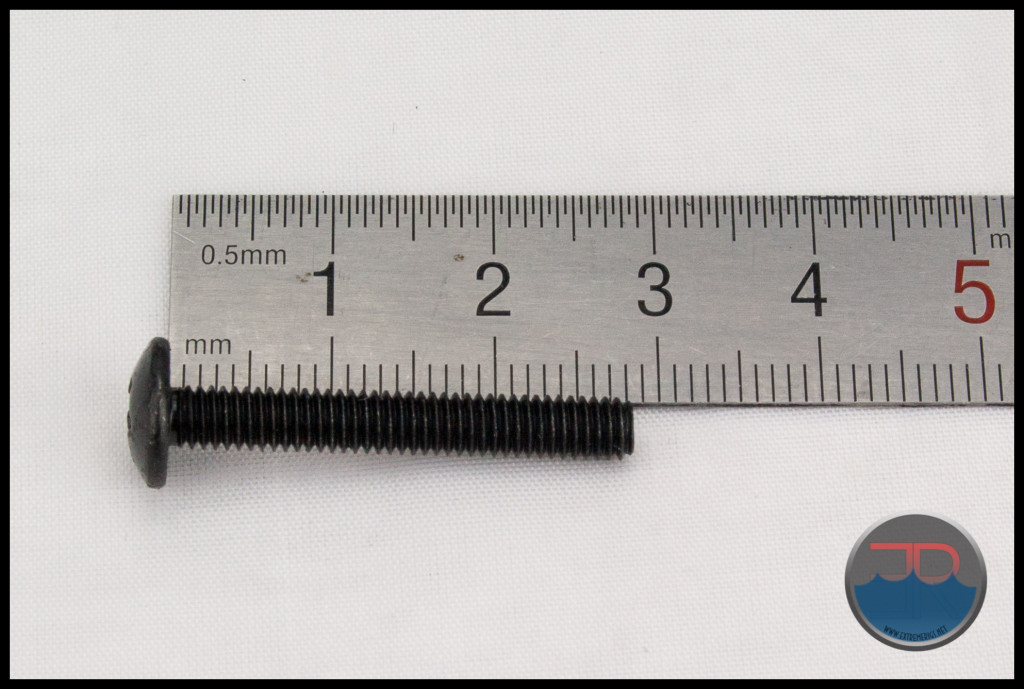 HWLabs also provides some spare port plugs aka stop fittings. 4 x extra port plugs come with the Multi-Port version of the SR2. These are in addition to 6 that are pre-installed into the ports of the radiator. This is great because the radiator is ready for flushing straight from the box. This means it comes with a total of 10 stop fittings, which is great, but somewhat overkill. Because of this HWLabs had to keep the cost down and so these are not made of brass but instead of POM aka Delrin. In other words they are plastic and if you note there is an allen key socket in the head for tightening it.
HWLabs also provides some spare port plugs aka stop fittings. 4 x extra port plugs come with the Multi-Port version of the SR2. These are in addition to 6 that are pre-installed into the ports of the radiator. This is great because the radiator is ready for flushing straight from the box. This means it comes with a total of 10 stop fittings, which is great, but somewhat overkill. Because of this HWLabs had to keep the cost down and so these are not made of brass but instead of POM aka Delrin. In other words they are plastic and if you note there is an allen key socket in the head for tightening it.
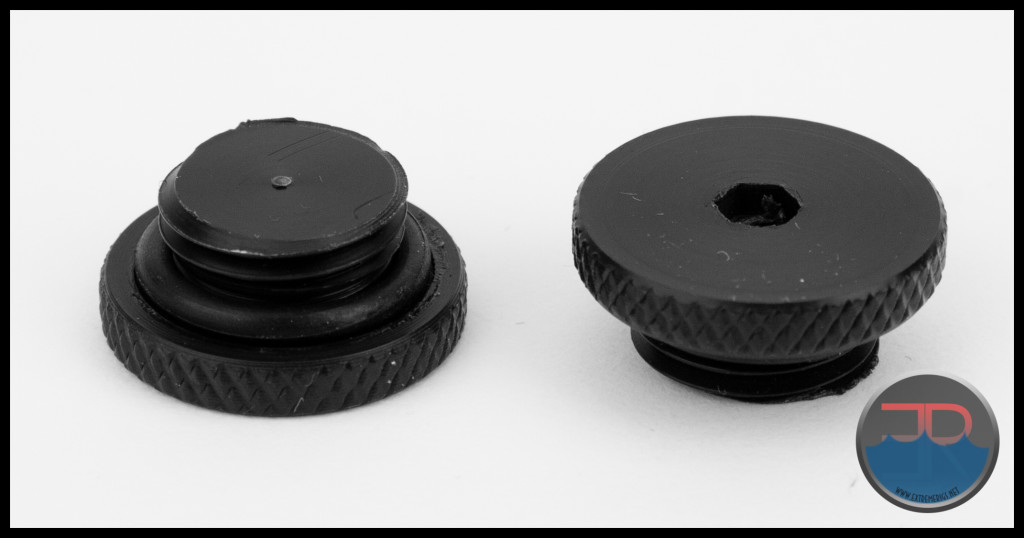 HWLabs recommends only using fingers to tighten because of this. However given that using an allen key is an optional method of tightening/loosening these plugs the recessed key hole will (and does) round off after a couple of uses. In fact some the plugs fitted on the rad were partially rounded off from the factory fitting straight from the box. Ultimately end users will decide whether or not they choose to replace these factory fitted plugs with plated/painted brass ones. I suspect that most will be happy to keep the stock plugs in place as they certainly are convincing and do look good. I think HWLabs made a good decision to include all the port plugs (inc. the 4 extra) and so the cost saving benefit of using the plastic material is justified.
HWLabs recommends only using fingers to tighten because of this. However given that using an allen key is an optional method of tightening/loosening these plugs the recessed key hole will (and does) round off after a couple of uses. In fact some the plugs fitted on the rad were partially rounded off from the factory fitting straight from the box. Ultimately end users will decide whether or not they choose to replace these factory fitted plugs with plated/painted brass ones. I suspect that most will be happy to keep the stock plugs in place as they certainly are convincing and do look good. I think HWLabs made a good decision to include all the port plugs (inc. the 4 extra) and so the cost saving benefit of using the plastic material is justified.
Onwards to technical specifications!
Technical Specifications
Technical specifications: as listed by HWLabs.
![]()
• 9 FPI 45 Micron Copper Fins
• Optimized for sub-800 rpm ultra-stealth fans
• Supercruise™ optimizations for scalable performance with higher speed fans
• 50% more tubing area than the Black Ice® SR1
• Increased internal coolant flow rates optimized for multi-stage cooling configurations
• Standard G 1/4″ inlet/outlet fittings
• Standard M4 mounting threads
• Compatible with Black Ice® GTX® and Black Ice® SR1® radiators
• Custom Black Carbon™ high quality finish
• Fully ROHS Compliant
• 100% Made from conflict-free materials
• Industry standard Black Ice® quality
• Lifetime warranty against manufacturing defects*
The following tech drawings are of the SR2 240 MP, but note that none of the dimensions take consideration for the extra 4mm that each port plug requires.
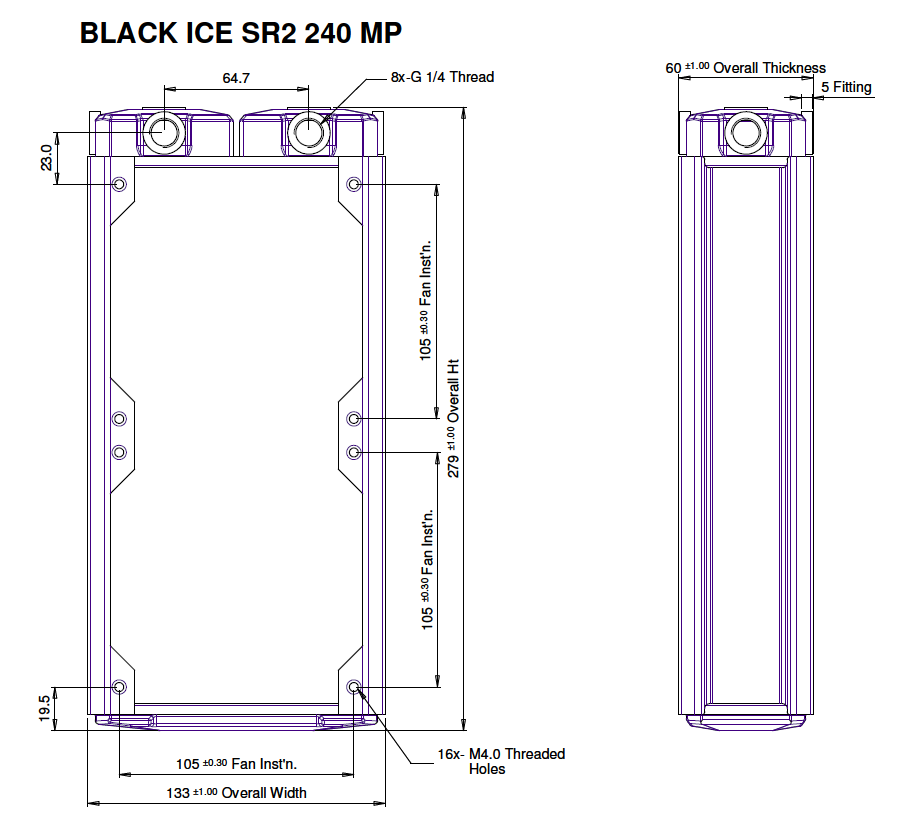
I made mention above of the extra 4mm on each port adding to the dimensions. The following photo shows that each port face is flush with the casing, a ruler is placed over one of the side ports. So whatever plugs you use, their length should be added for a final dimension size.
Dimensions Measured on the Radiator Tested:

The (+4) and (+4 +4) are the addition measurements if the supplied port plugs are fitted.
Radiator Core Dimensions:

The core is made up of 3 rows of 12 tubes arranged in the standard U-Flow configuration. The fin arrangement is made of single louvered fins with a 9 FPI count. The low fin count should equate to some decent Push Only results, but might not be so competitive in the Push/Pull comparisons.
This picture is a reference which shows a typical U-Flow coolant flow path, where the coolant travels up all the tubes on one side (left in pic) of the rad and then returns down the other side. U-Flow is most easily recognized when the port end has 2 separate tanks such as the SR2 240 MP has.
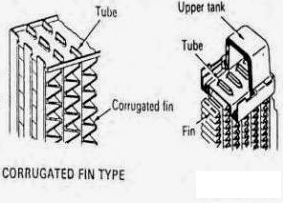 The single louvered fins are spaced extremely evenly between the tubes and here we see the 9 FPI count as per the specs.
The single louvered fins are spaced extremely evenly between the tubes and here we see the 9 FPI count as per the specs.
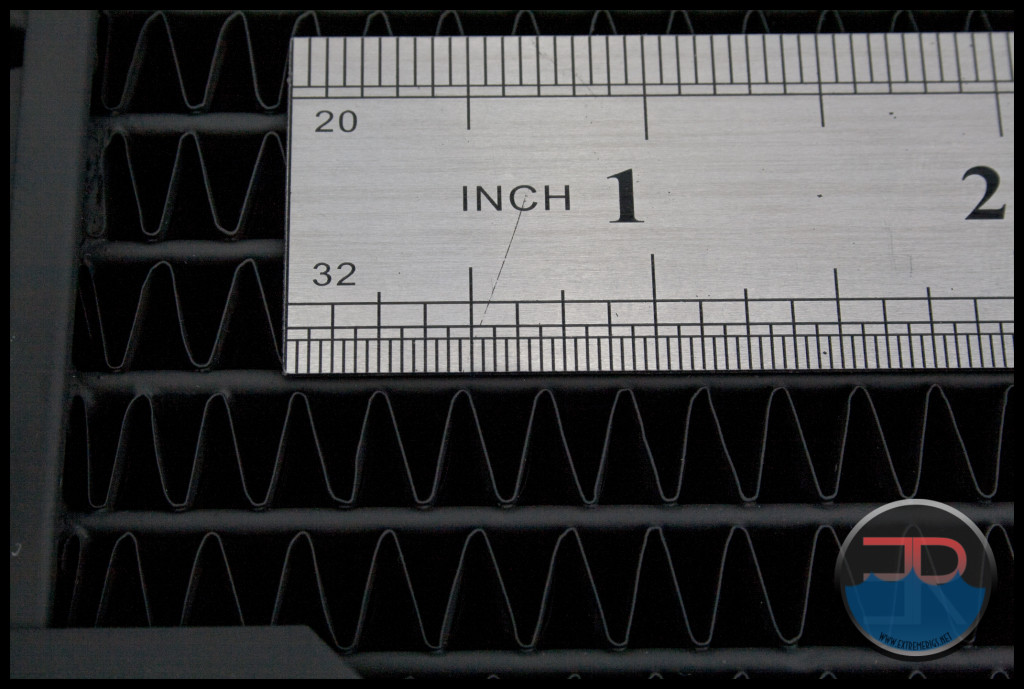
Finish and Features
The SR2 240 MP has a true Matte Black finish and is my preferred finish for a radiator in most builds. It has a subtle yet stylish finish which would look great in most installations. HWLabs are renowned for the build quality and finish of their radiators and the SR2 MP keeps up the tradition with all visible joints appearing to be perfect and the paint finish is flawless.
In a change from the original SR2 the logo down the side panels has been dropped for the MP versions. It is refreshing to see a manufacturer not feeling obliged to plaster their products with their own logos.
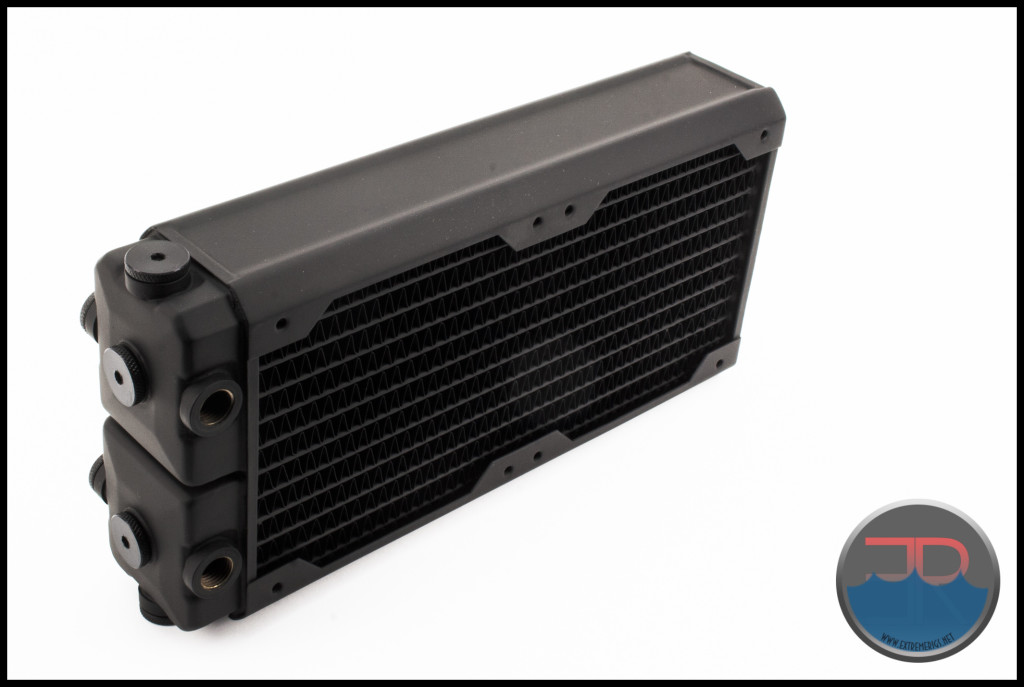 The fan mount spacing is the standard 15mm. There is only a couple of threads to work with here so take care when starting off the fan screws as there probably won’t be a second chance if you strip the threads. Turn the screws anti clockwise first until you fell it “click” into the start of the thread, then tighten clock-wise to secure.
The fan mount spacing is the standard 15mm. There is only a couple of threads to work with here so take care when starting off the fan screws as there probably won’t be a second chance if you strip the threads. Turn the screws anti clockwise first until you fell it “click” into the start of the thread, then tighten clock-wise to secure.
The fan mounting holes are not located directly above tubes; however they are very, very close so it is great that HWLabs chose to incorporate protection plates. Still, care must be taken if you need to use custom length screws due to your mounting needs.
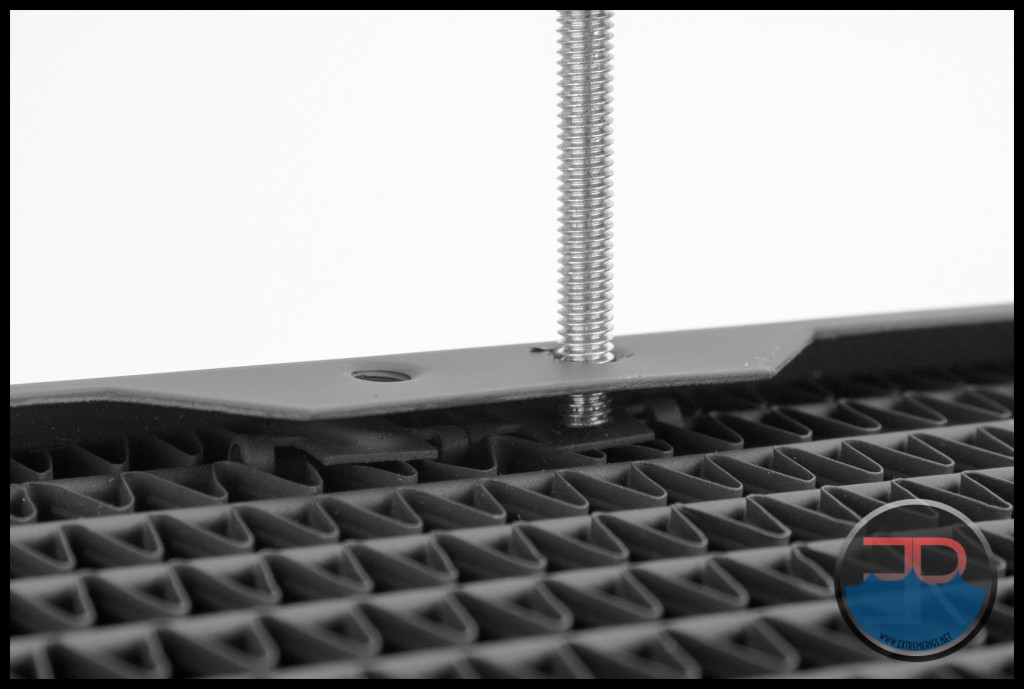 The SR2 Multi-Port comes equipped with 8 ports in total, 4 for each inlet and outlet to choose from. This heralds the start of HWLabs multi-port radiators and I for one hope they will be updating other models which are suitable for the multi-port option – this however would exclude any of the GTX range due to its internal flow path configuration.
The SR2 Multi-Port comes equipped with 8 ports in total, 4 for each inlet and outlet to choose from. This heralds the start of HWLabs multi-port radiators and I for one hope they will be updating other models which are suitable for the multi-port option – this however would exclude any of the GTX range due to its internal flow path configuration.
The extra ports give us options for dedicated fill ports or drain lines/taps and fitting of temp sensors depending on the installation orientation. In addition the extra ports could allow for better tubing runs or even hidden tubing without the need for angled fittings. We love multi-port radiators!
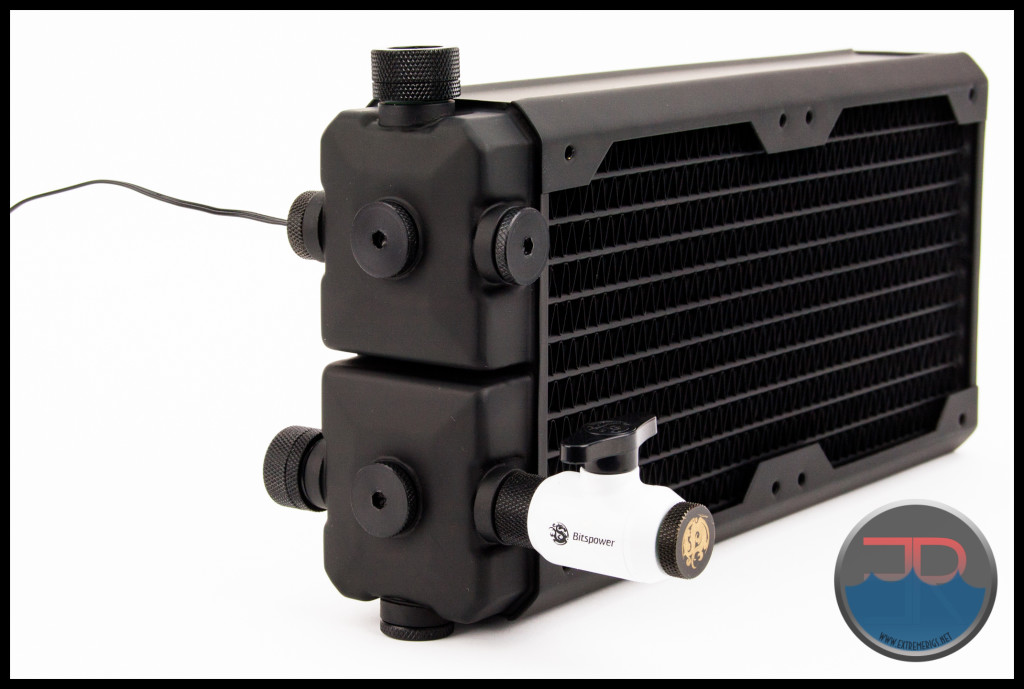
The SR2 240 MP is looking great and ready for business.
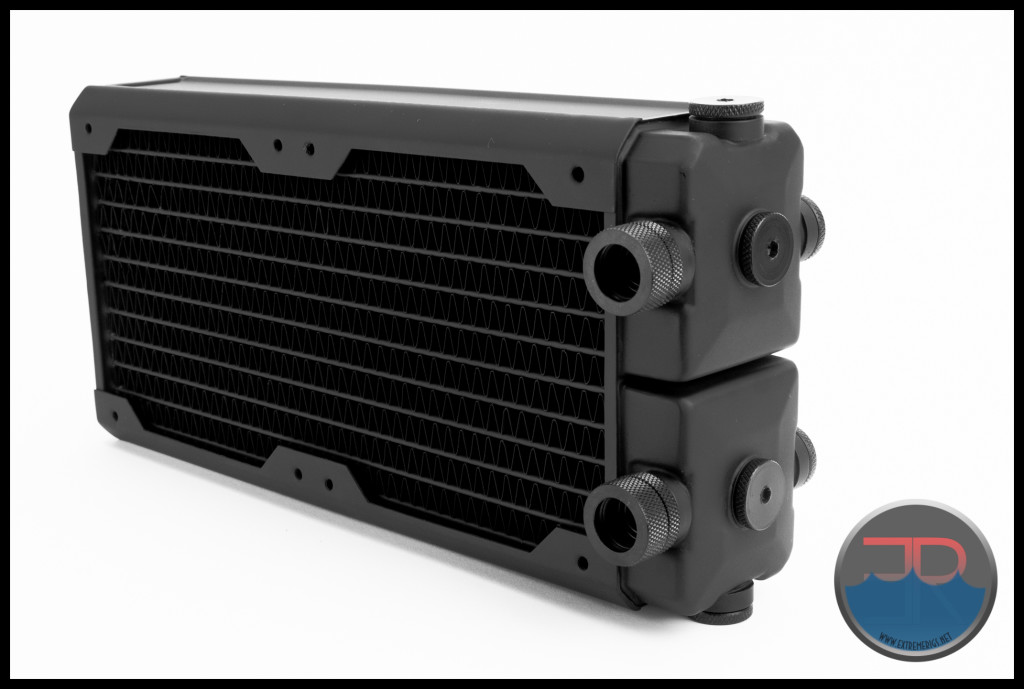
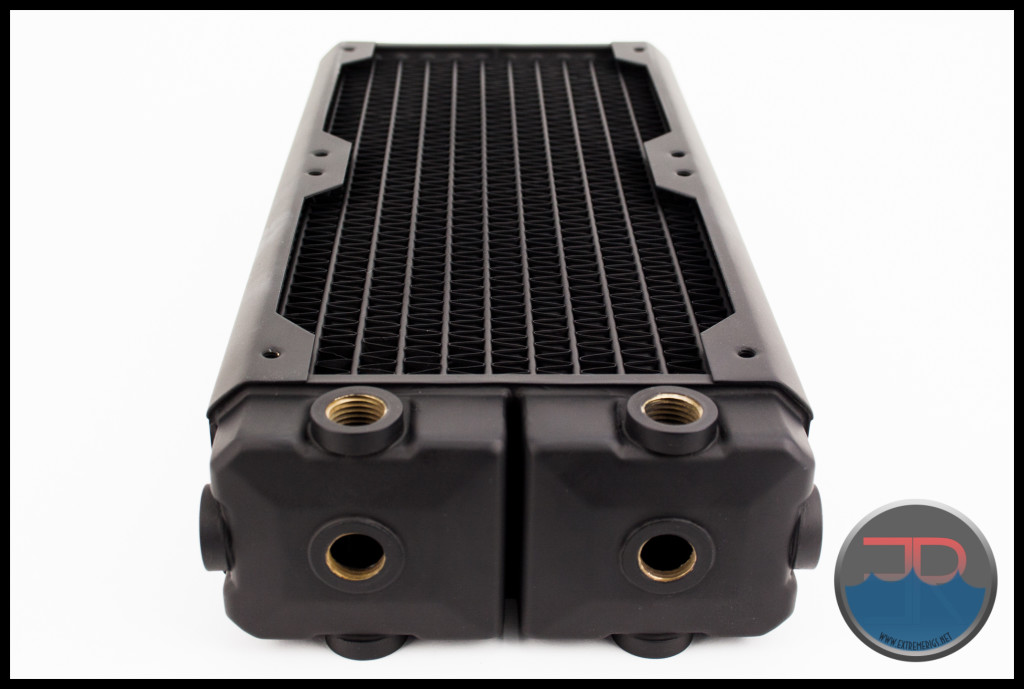 Unfortunately there is no dedicated fill/bleeder port on the return end tank. We hope that HWLabs takes on the feedback from its customers and that future revisions will have this port added to complete the port set and add flexibility for vertical installations. 8 ports are great – but 8 + 1 would be better still!
Unfortunately there is no dedicated fill/bleeder port on the return end tank. We hope that HWLabs takes on the feedback from its customers and that future revisions will have this port added to complete the port set and add flexibility for vertical installations. 8 ports are great – but 8 + 1 would be better still!
So here we have a 60mm thick rad with a low FPI count that is sporting a massive total of 8 port options. The matte black finish is excellent as is the overall build quality.
Prior to any testing I thoroughly flush each rad with a hot water rinse from the mains for at least 15 minutes, followed by our traditional “shake – a – rad” dance. The SR2 models do have more particles coming out during the flushing process than I recall seeing in other HWLabs models. It was a long dance with the 240mm version, requiring 6 steps until I was satisfied that all particles had been removed.
We contacted HWLabs with our concerns abut the unusual amount of green and black particles that were being flushed out. HWLabs replied that it was residue from the braze paste, likely from the extra ports that have been fitted, and that the issue will be addressed for the retail production units.
Let’s see how it performs…
Flow Rate Testing
The Data
All the testing was performed with the exact same equipment, using the exact same methods as was used in the 360mm round-up so I have decided to keep this review uncluttered by keeping our testing methodology, test set-ups and equipment used in a single location. To see exactly how the tests were carried out, details of the test set ups and equipment used, please head over to the RRU Test Setup page.
Restriction Test
It’s generally agreed that radiators are one of, if not the least restrictive components in the water cooling loop. There are some exceptions however, so this must still be verified through testing:
The above photo is for referencing the restriction test bench The SR2 240 MP is not loaded so please disregard the data in the picture as it does not relate to the its test results.
Here is the raw data at the tested flow rates, displaying the measured Differential Pressure across the radiator as flow rate was increased.
 The table numbers indicate that this SR2 is a very low restriction radiator. However numbers in isolation can only tell half the story. By plotting against other components it more easily shows the whole story.
The table numbers indicate that this SR2 is a very low restriction radiator. However numbers in isolation can only tell half the story. By plotting against other components it more easily shows the whole story.
I have decided to use a HeatKiller 3.0 CPU block as the reference in this next plot for two reasons. Firstly there is no chance of the plot being cluttered by curves overlapping and secondly it gives a reference point against a fairly common loop component of average restriction.
As with all previous radiator restriction plots, I have limited the maximum flow rate displayed to 2.0 GPM as I suspect there are very few systems that operate above 2.0 GPM. For more information on how to read a restriction plot check out our guide.
 This plot confirms the SR2 240 MP as a low restriction radiator, extremely low I would even venture to say.
This plot confirms the SR2 240 MP as a low restriction radiator, extremely low I would even venture to say.
The next three plots show the restriction level at three different flow rates compared to the other 240mm radiator that has been tested so far. We consider the chosen GPM rates to represent systems which have low, medium and high flow rates.
 Clearly the SR2 MP has the lower restriction level of the 2 rads and is due to it’s much larger tube size. This is not to say the EK XE is overly restrictive, just that the SR2 is much less so.
Clearly the SR2 MP has the lower restriction level of the 2 rads and is due to it’s much larger tube size. This is not to say the EK XE is overly restrictive, just that the SR2 is much less so.
This next plot shows both 240 rad’s results for the full range of the flow meter we use for testing the restriction level.
 To give a bit more perspective, lets take a look at both rads data again in table format but in a first let’s start to compare some different size rads for restriction levels.
To give a bit more perspective, lets take a look at both rads data again in table format but in a first let’s start to compare some different size rads for restriction levels.
We’ll stick to only the 1.0 GPM flow rate to keep some sort of a constant, but into the mix we’ll put data from an assortment of radiator sizes.
This has the very lowest and the very highest we have recorded as well as a mix of other rads, mostly from the same manufacturers.

So in the bigger picture of radiator restriction the SR2 240 MP does indeed have a very low restriction level.
Onwards to Thermal Performance!
Thermal Testing
The Thermal Data
In a change from the 360mm thermal testing, all other radiator sizes are only going to be tested at 1.0 GPM. We proved that for 95% of the rads tested, flow rates over 1.0 GPM did not make any significant impact on the radiator performance. The decision to only test at 1.0 GPM is also because of the time required to complete this testing, and running the additional flow rates effectively doubled the required test time.
A total of 6 tests were conducted at 1.0 GPM with fan speeds of 750 rpm, 1300 rpm and 1850 rpm being run in Push Only and Push/Pull. All inclusive this testing still takes between 40 – 50 hours of logging time to get the results that are presented.
Below is the final data results gathered from at least 5 data logging runs at the flow rate and fan rpm combination. The most stable 15 minute period from each logging run was used and then averaged with the other runs to obtain the data for the table below. A total of 16 temperature sensors were used in the thermal test chamber (8 air in, 2 air out, 3 water in, 3 water out) each take a reading every second and logged via a CrystalFontz unit.
The data in the table below is the averaged results of the logging runs which has then been used to create all the plots and tables there-after.
The performance metric of critical importance is the delta between the warm coolant temperature in and the cold ambient air temperature in to the radiator. Given that the system is well insulated and in equilibrium and we know the heat input to the system then we can also calculate a very important number – that is the amount of power required to raise the coolant temperature 1C (or 10C which is a more useful reference point).
Let’s take a look at the Delta T results from the tests. Note that the extrapolation of the curve is much more sensitive to error than in between the tested range.
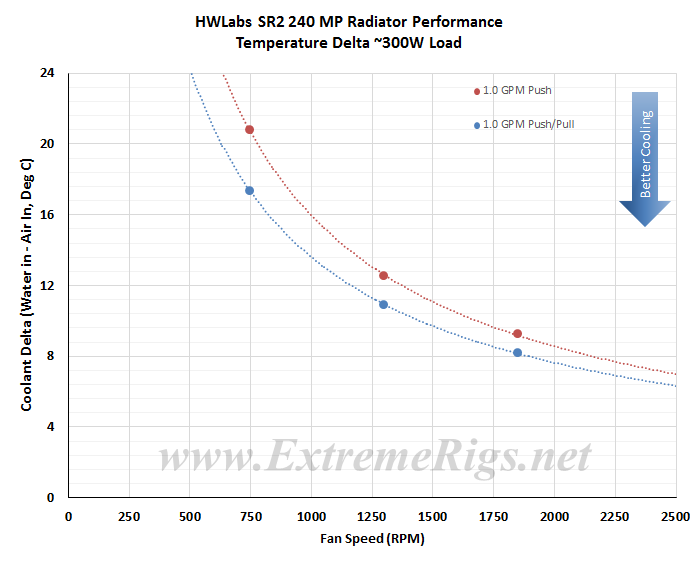 I was not too concerned about the actual delta numbers, more so the trend pattern, and as we should expect, the deltas come down significantly as the fan speed is increased.
I was not too concerned about the actual delta numbers, more so the trend pattern, and as we should expect, the deltas come down significantly as the fan speed is increased.
Remember back when I was cringing at HWLabs style of presenting the performance rating of 950 watts with a 25°C Delta, well doing the maths on our Push/Pull 1850 rpm test result with an adjusted delta of 25°C we end up with a power dissipated result of 962 Watts. This is of course pure coincidence that our results are so close given the difference in setups and has no real meaning but I found it to be a fun trivia fact and it gives credence to the HWLabs data.
Delta T results (as above) are not always helpful when thinking about how many radiators you would need to cool your system. Instead it’s more useful to know the delta/W, or more usefully, the inverse metric of W/delta C. The metric plotted below tells us how many watts are dissipated by the radiator when the coolant rises 10C above ambient temperatures. (W/10 Delta T):
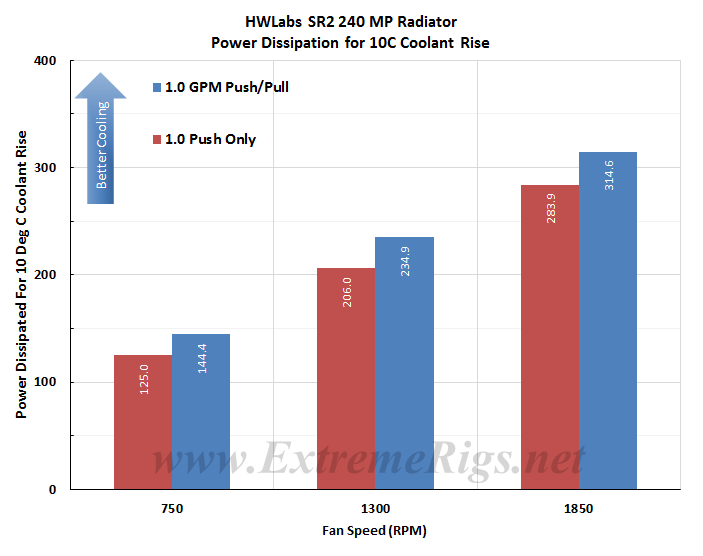 This same data can now be plotted on a chart so that an end user can interpolate their own fan speed. Note again that the extrapolation of the curve is much more sensitive to error than in between the tested range.
This same data can now be plotted on a chart so that an end user can interpolate their own fan speed. Note again that the extrapolation of the curve is much more sensitive to error than in between the tested range.
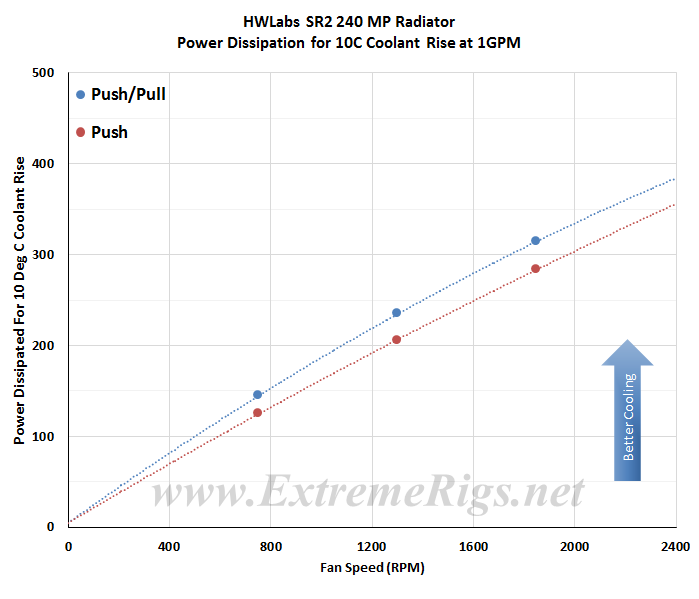 With the SR2’s low fin count of 9 FPI, the results show that a Push Only fan assembly is very efficient on this radiator at all RPM’s, and that adding a second set of fans (Push/Pull) only yields an average performance increase of ~12%.
With the SR2’s low fin count of 9 FPI, the results show that a Push Only fan assembly is very efficient on this radiator at all RPM’s, and that adding a second set of fans (Push/Pull) only yields an average performance increase of ~12%.
Now let’s analyze that data some more…
Data Analysis
This first table shows the SR2 240 MP’s Watts/10 Delta Temp numbers in a quick glance chart format.

Using this data we can effectively show percentage gains/losses relative to a reference point. It’s an interesting way to show gains/losses while changing a variable.
So, let’s focus on 1300 RPM as our reference and see how much gain or loss in performance we get by changing fan speed.

Very even results either side of 1300 rpm indicate that the core is tuned well for low speed fans as we don’t see any major boost in performance as fans speeds are increased.
So from the data above we have a good idea of how the SR2 240 MP radiator performs relative to itself in Push Only and Push/Pull at various fan speed, but there is a large selection of 240mm radiator models to choose from, released from numerous manufacturers.
As we have another 240mm rad with testing complete, let’s compare by putting the SR2 240 head to head with EK’s XE 240. It may not be the fairest comparison ever done because while they are both 60mm thick, the EK XE has a much denser core that should result in much better thermal results. However we’ve been surprised by comparison results before.
Push Only Data vs Competition
Let’s focus on the Push Only results for now and come back to the Push/Pull data later.
Let’s start with 750 RPM and see how it compares to the competition:

Interestingly this is the data point where the SR2 240 MP is most likely to beat the EK rad due to it’s less restrictive core, but being ~6% behind that clearly is not the case. Looking back at the 360 comparisons for these 2 radiators, the SR2 did actually beat the XE at this data point. The different result might be attributed to the higher delta temps of the 240mm tests which the XE may have responded better to. I.E. the 240 radiators used the same 300W heater that the 360 radiators used.
Now let’s look at 1300 rpm:

At 1300 rpm the SR2 falls further behind, now 13% behind the leader.
 At 1850 rpm the SR2 picks up a couple of percentage points, when one might have expected it to fall further behind. I suspect this may be because the SR2’s low FPI is less efficient with higher rpm than the EK’s core. This lower air efficiency resulted in a higher coolant temp, which in turn makes the radiator more efficient.
At 1850 rpm the SR2 picks up a couple of percentage points, when one might have expected it to fall further behind. I suspect this may be because the SR2’s low FPI is less efficient with higher rpm than the EK’s core. This lower air efficiency resulted in a higher coolant temp, which in turn makes the radiator more efficient.
So it appears (as expected given the low PFI count) that the SR2 is well tuned for low fan speeds, but the EK model does still outperform it. Will the SR2 perform similar to other low FPI rads where they perform best in Push Only applications, or can the SR2 hold its own in Push/Pull also?
Let’s find out…
Push/Pull Data vs. Competition
Let’s now look at the Push/Pull results and see how the SR2 compares:
 The SR2 takes second place ~7% behind the XE, and virtually mirrors the Push Only result in terms of the percentage it is behind.
The SR2 takes second place ~7% behind the XE, and virtually mirrors the Push Only result in terms of the percentage it is behind.
Let’s move to 1300 rpm:

In the 1300 rpm Push/Pull category the SR2 240 MP has dropped a few percent and is now 11% behind the XE.
Now 1850RPM:

As with the Push Only result the SR2 regains some ground on the EK rad, but at ~8% behind it is clearly the weaker performer.
Let’s also combine the Push Only and Push/Pull results at our 1.0 GPM flow rate into one plot for each fan speed tested.
Again the 750 rpm first:

Nothing looks out of place here given the data we have reviewed already.
At 1300 rpm everything looks in order given the data we’ve already reviewed. Of interest though is how close the EK rad in Push Only came to beating the SR2 in Push/Pull.
It was exactly the same with the 1850 combined.
 From all of test results we created “Average Performance Factor” charts for both Push and Push/Pull and then a combined plot called the “Master Performance Factor”. The radiator with the best cooling ability (W/10ΔT) at each rpm was awarded a score of 100, and each other radiators W/10ΔT result was scored as percentage of the top performer.
From all of test results we created “Average Performance Factor” charts for both Push and Push/Pull and then a combined plot called the “Master Performance Factor”. The radiator with the best cooling ability (W/10ΔT) at each rpm was awarded a score of 100, and each other radiators W/10ΔT result was scored as percentage of the top performer.
This way of looking at the comparison takes away any advantages that a radiator may have at higher or lower fan speeds and looks at an overall average. While this appears fair it does tend to favor those radiators that are all-rounders and those radiators which do very well at high RPM. Most users should be more focused on their specific use case.
Here is the SR2’s percentage scores at each data point that thermal tests were conducted at with the addition of the SR2’s Push Only results relative to the Best performing Push/Pull results

The percentage numbers in the table offer another way of looking at the SR2’s results comparatively and how it performed, but for our scoring system we need a way to reduce the categories while retaining the data. To do this we average the results for each fan assembly type giving us Averaged Performance Factors for Push Only, Push/Pull and finally an average of everything in the Master Averaged Performance Factor.
Firstly – the Push Only APF:
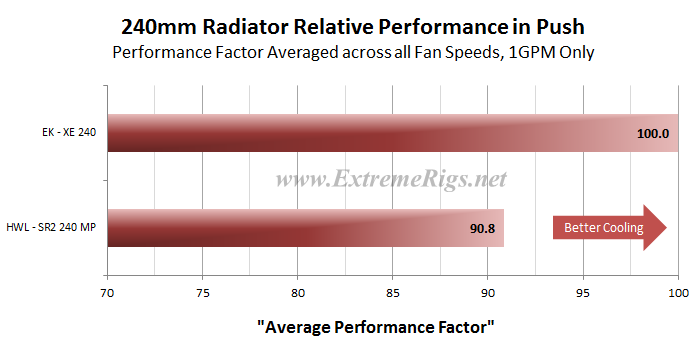 The SR2 achieved consistently good results across all fan speeds while not taking out any first places.
The SR2 achieved consistently good results across all fan speeds while not taking out any first places.
Now the Push/Pull APF:
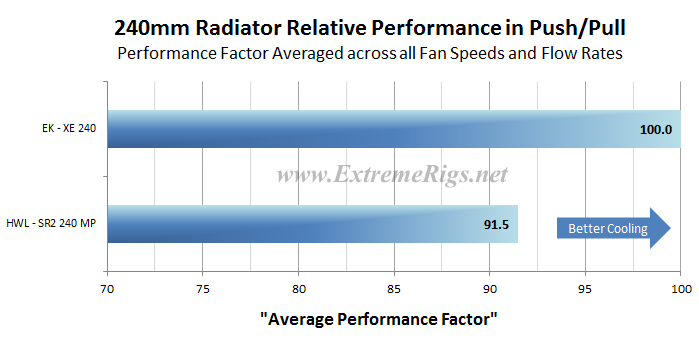 With a much lower FPI count than the EK XE we didn’t expect miracles from the SR2 in the Push/Pull head to head, but we were surprised that it kept up as well as it did.
With a much lower FPI count than the EK XE we didn’t expect miracles from the SR2 in the Push/Pull head to head, but we were surprised that it kept up as well as it did.
Finally we created the Master Performance Factor which is calculated from the averaged results of all the Push Only and Push/Pull thermal tests, at all fan speeds.
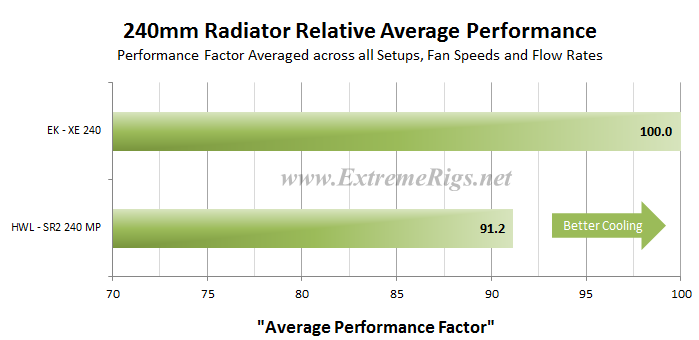
So the SR2 240 MP finishes around 9% behind the XE rad in the performance rankings.
Some of you may be wondering by now why these comparison results differ to the 360mm results where the EK rad was ahead of the SR2 in each category but the results were much closer. The answer to that lies in the way in which we tested the SR2 240 MP, and as stated earlier we tested in the exact same way as we did for the 360mm version to get the comparisons – the key word here being comparisons.
So before we conclude, let’s take a look at those comparisons and see if we can explain the result differences. We did test the 360mm version at 3 flow rates, but only the 1.0 GPM data has been used in the charts below.
 Having done then 360mm testing previously we had to decide how we were going to set up for testing other sizes. There were two practical options, both of which had advantages and disadvantages and none of the ER staff could ever really agree on which was the better option.
Having done then 360mm testing previously we had to decide how we were going to set up for testing other sizes. There were two practical options, both of which had advantages and disadvantages and none of the ER staff could ever really agree on which was the better option.
The first option was to run a power load proportional to that which was run for the 360mm rads, which was 300 Watts. For 240mm rads that would be 200 watts, being 66% of the surface area of a 360mm rad. This would show us the scalability of the different size of each model rad quite well, but the comparison results would be likely to end up in the exact same order as the 360mm Round Up and therefore maybe not the best comparison for readers who may be looking to purchase one or the other size of a particular radiator.
Another problem with this option is that the heater used for testing is 300 Watt, so for larger rads such as 420mm, 480mm and 560mm another heater would need to be incorporated in the test chamber loop, which would be a big change to they system in itself that would likely then render the test system useless for comparisons to older test data (any system change makes things no longer apples to apples – and yes the system is that sensitive).
The second option, which is what we have decided to use, was to run with 300 Watts on the 240 radiators. This mirrors the fact that we keep the heatload constant even when changing fan RPM. This gives a good comparison between different sizes of the same rad, as we are simulating a set load in a similar way to which a running system might. The downside to this test method is that we may run into temperature issues. On the smaller 120mm and 140mm rads 300 Watts is just going to be too much for them to dissipate with safe and acceptable coolant temps, so we may end up not getting full sets of data, in particular the Push Only 750 RPM data point would be almost certain to have coolant temps which are too high to test at. On the other end of the scale for any 480mm or 560mm rads, the cooling potential is likely to be very high resulting in very lower Delta Temps which could lead to data having to be discarded, particularly for the Push/Pull 1850 RPM data point.
There is no right or wrong choice, the results would just be slightly different due to Delta Temps being different between the two test options. In the end we are happy with the option which we chose as we believe is offers the reader a better comparison between different size radiators as they have all been tested under the same conditions. However as a reader you should be aware that W/10DT numbers are not calculated here with a delta of 10C so radiators with higher temperature deltas are operating more efficiently and will score higher than perhaps they should for a true scientific accurate test of heat dissipation for a 10C delta.
Next up – Summary!
Summary
Thermal Performance
Thermal Performance scores are derived from the relevant Performance Factor scores. We set this scale with 72.5% and below as the 0 mark, with each 2.5% increase from 72.5% in relative performance adding 0.5 to the awarded performance score.
Push Only Thermal Performance
- 3.5/5
The SR2’s Push Only APF result of 90.8% translated into a thermal performance score of 3.5/5. The low 9 FPI fin count meant it was not able to match the performance of the 16 FPI EK Rad, so the results shouldn’t come as any surprise.
It seems apparent that our chosen method of testing will favor rads capable of greater heat dissipation, but the results are what they are and we are here to bring them to you.
Push/Pull Thermal Performance
- 3.5/5
The Push/Pull Performance result is pretty much a carbon copy of the Push Only with a score of 3.5 being generated.
Overall Thermal Performance
- 3.5/5
The Master Performance score of 91.2 gives a score of 3.5/5. Without more radiators in the test group, it really is difficult to put the comparison into perspective given the results here vary from that of the 360 round-up. However, with the head to head 240mm results we have it is clear that the SR2 240 MP was the weaker performer of the 2 rads tested.
Features & Quality – 4.0/5
The SR2 240 MP has HWLabs renowned build quality built into its DNA. It feels solid and weighty, is well constructed and the matte black finish is excellent.
The amount of extra ports introduced on this revised model is unexpected, unbelievable and most certainly welcomed. No other radiator has so many ports. These ports will surely be an irresistible lure to many rig builders. These extra ports are what HWLabs radiators have been missing for years, so we are very pleased they have caught up with the competition by adding the extra ports. The inclusion of tube protection plates is always a welcome feature and the very low FPI count means the SR2 will need cleaning less often than most other rads. In addition the SR2 has a very low restriction level which means less pump power is required when planning out your loop.
So some great positives there – now for the negatives. HWLabs recommends only using fingers to tighten the stop fittings because of the use of Delrin and a small hex head socket. In addition the SR2 MP is still missing a dedicated fill/drain port on the return end tank. The SR2 240 MP would have come close to scoring a 5/5 for features and quality had this been included. The other negative is the amount of particles which were present and removed during flushing of the review sample. We will never get away from flushing rads so long as soldered tube rads are used, so cleaning new rads will always be required. HWLabs have advised that this issue will be rectified for the retail units and that it was something to do with the brazing paste used on the extra ports.
Summary – Silver Award 4.0/5
The 360mm version of the SR2 MP proved to be an excellent all round thermal performer – while it performed best at lower fan speeds it also proved to be quite scalable. However, the thermal Test conditions did not favor the 240mm variant quite as well as the 360mm. The consistency was still there but performance was weaker when compared to the same competitor. For this reason we couldn’t give it a Gold award.
The design, build quality and finish are excellent. The retail review sample was perfect and there really is nothing to complain about the finish.
A note of caution: be sure to take some measurements of the intended installation location prior to purchase, keeping in mind that unused ports will add an additional 4mm to the size to account for a port plug. So if both side ports are unused and port plugs to be fitted, the rad is effectively ~8-10mm wider, which could be a deal breaker for some chassis, particularly if front mounted.
Make no mistake, this radiator is all about all round performance coupled with the port options. You’ll soon forget about a slight performance loss because of the ease at which your loop goes together with multiple inlet and outlet orientations to choose from. The port choices could mean cleaner tubing runs or even hidden tubing plus the option to install other accessories like temp sensors or drain taps. Users with pedestals, basements or lofts are going to rejoice with the new found freedom the side ports will bring to loop assembly. While the price won’t be the cheapest the end result may save you money by spending less on pricey fittings like these or by using less pumps because of the low restriction.
Overall the SR2 is a great radiator. While it’s not perfect it would still be our first choice for any build and for these reasons it earns a Silver Award.
Where to buy: Performance PCs – Old SR2 240 – $73, Multiport version not yet in stock…




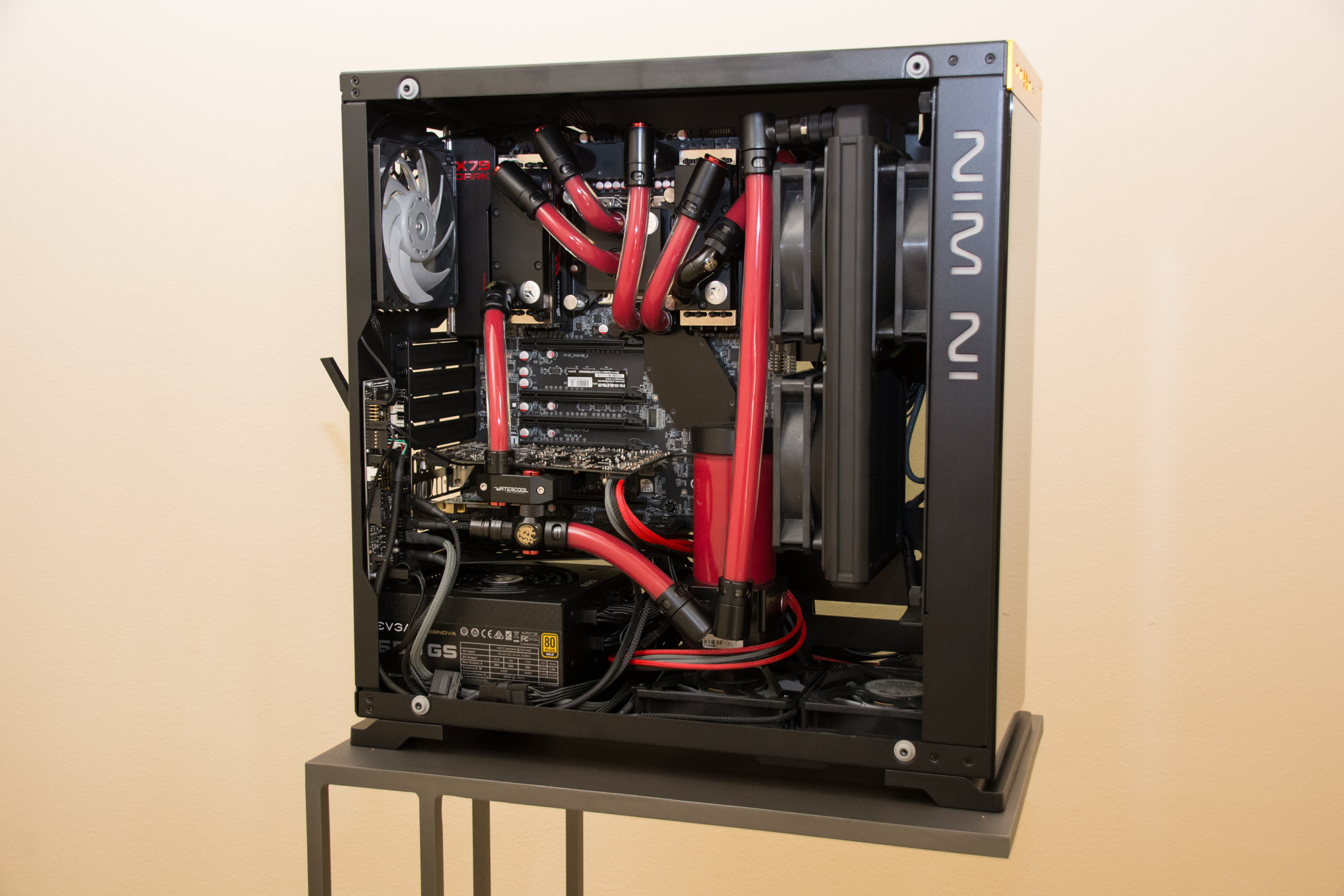
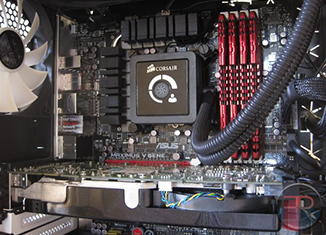

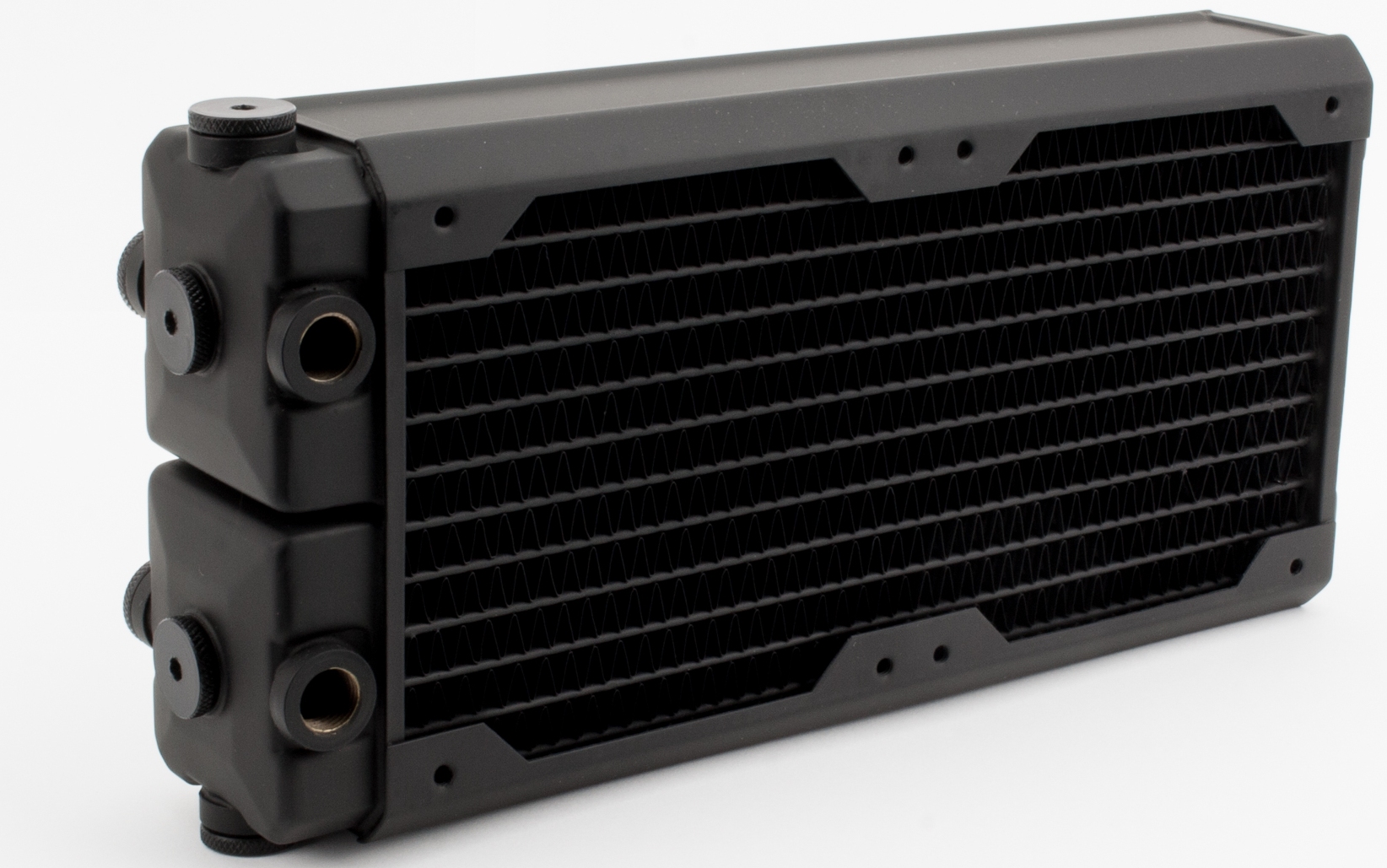
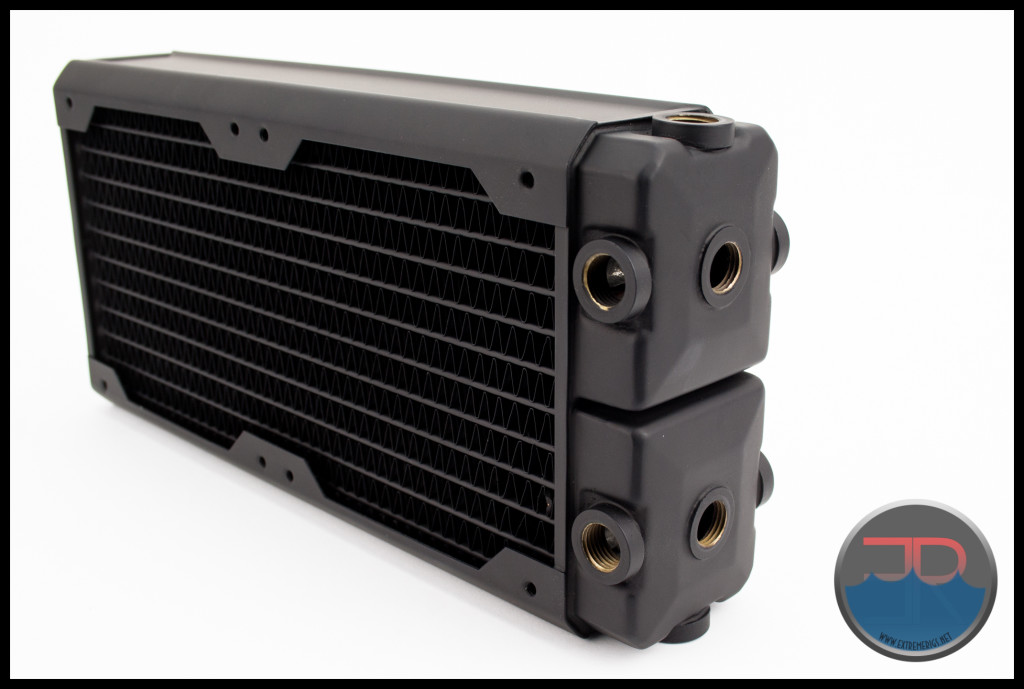
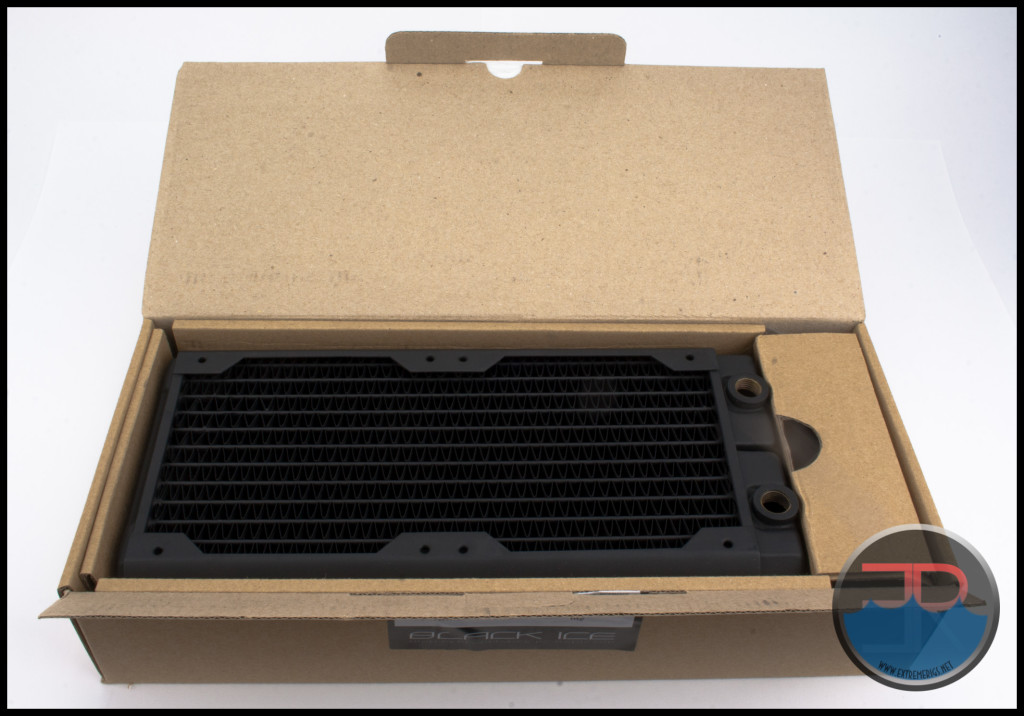
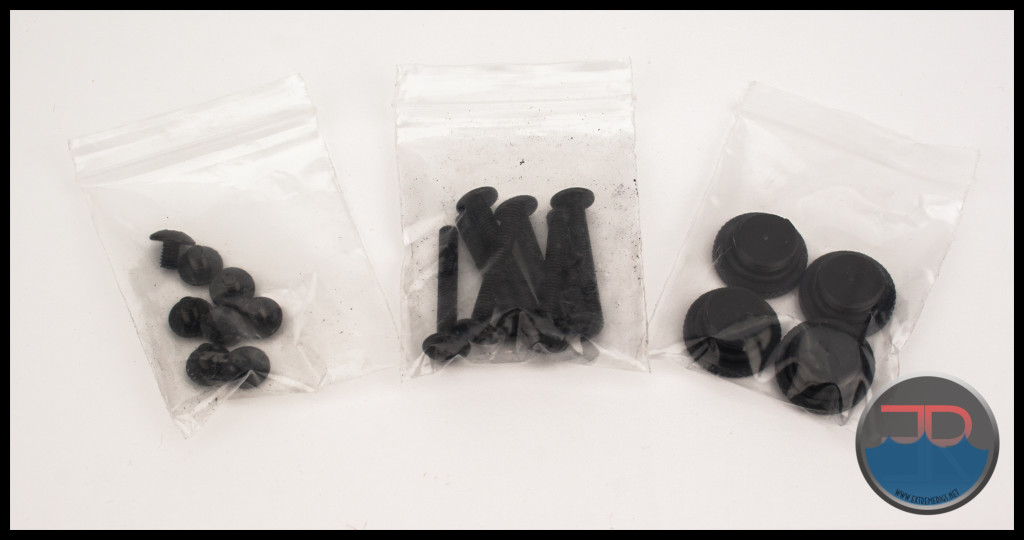
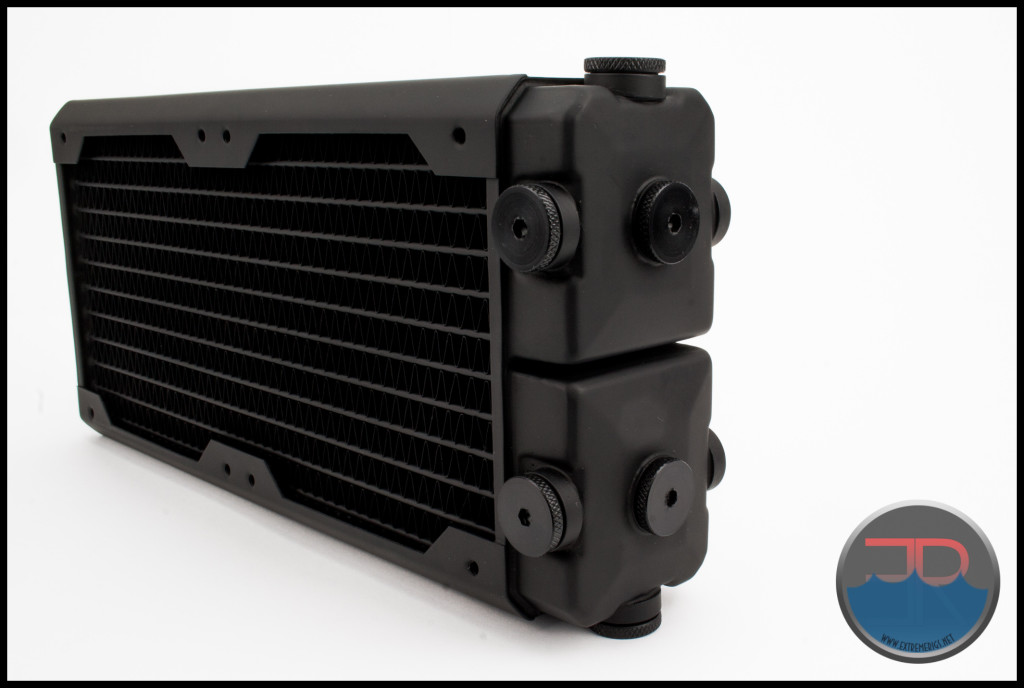

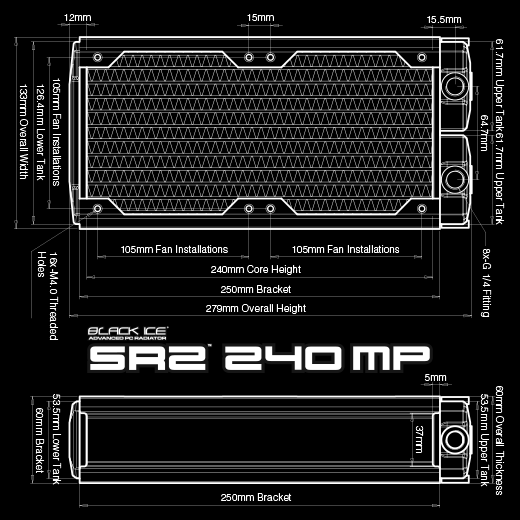
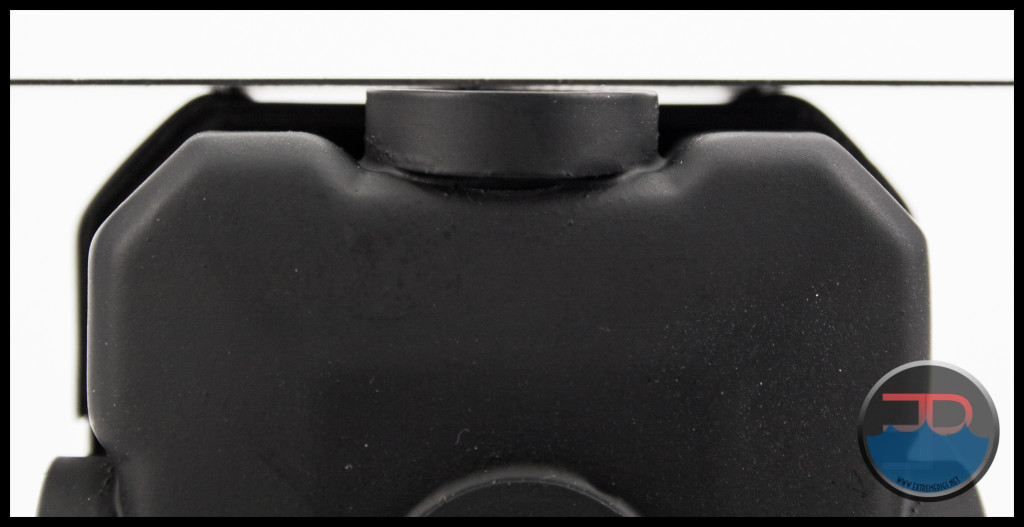
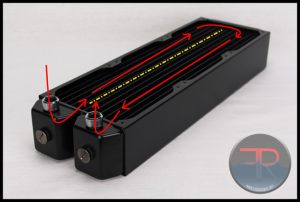
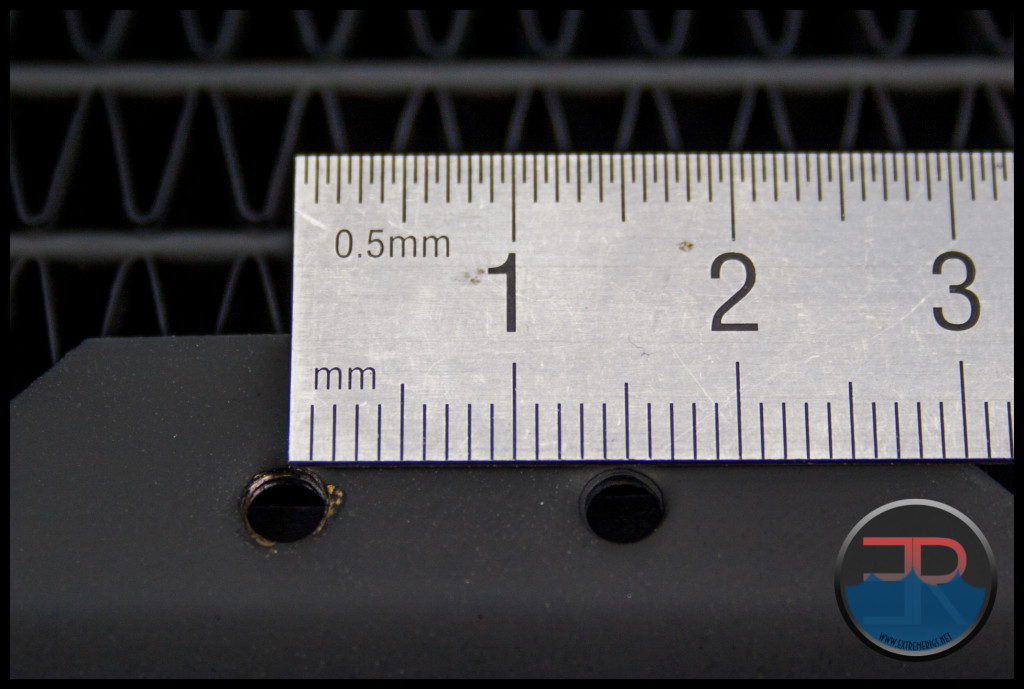
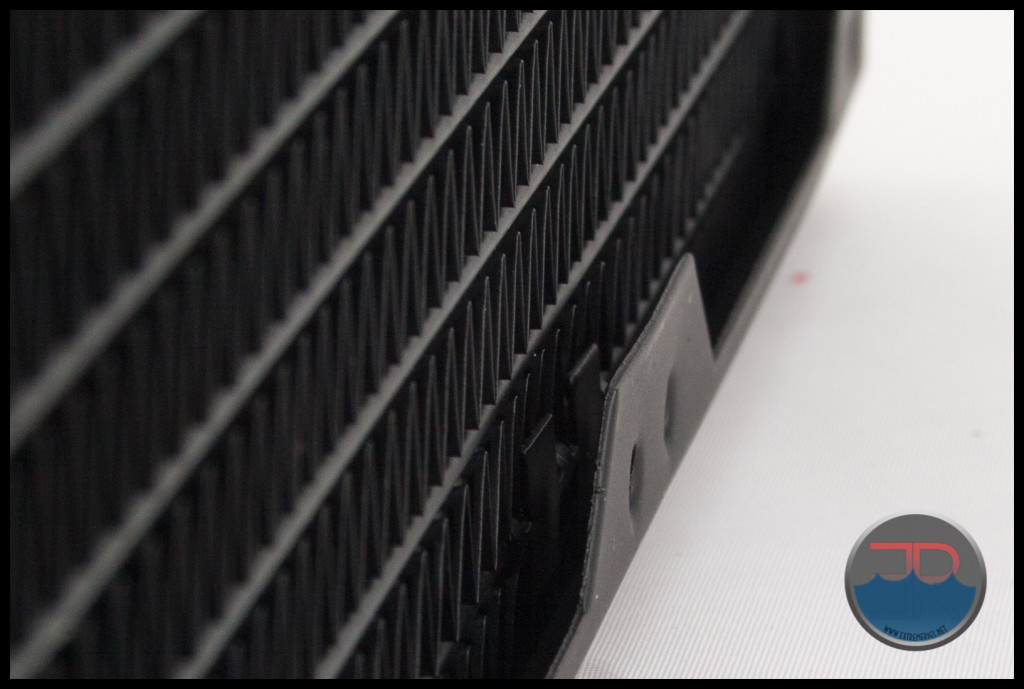
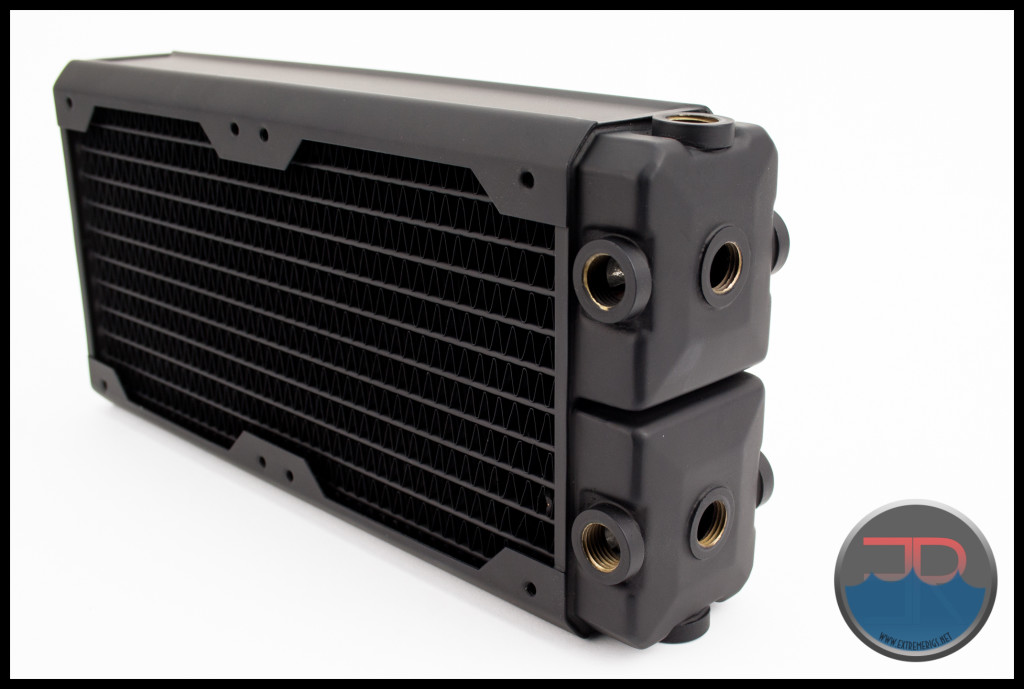
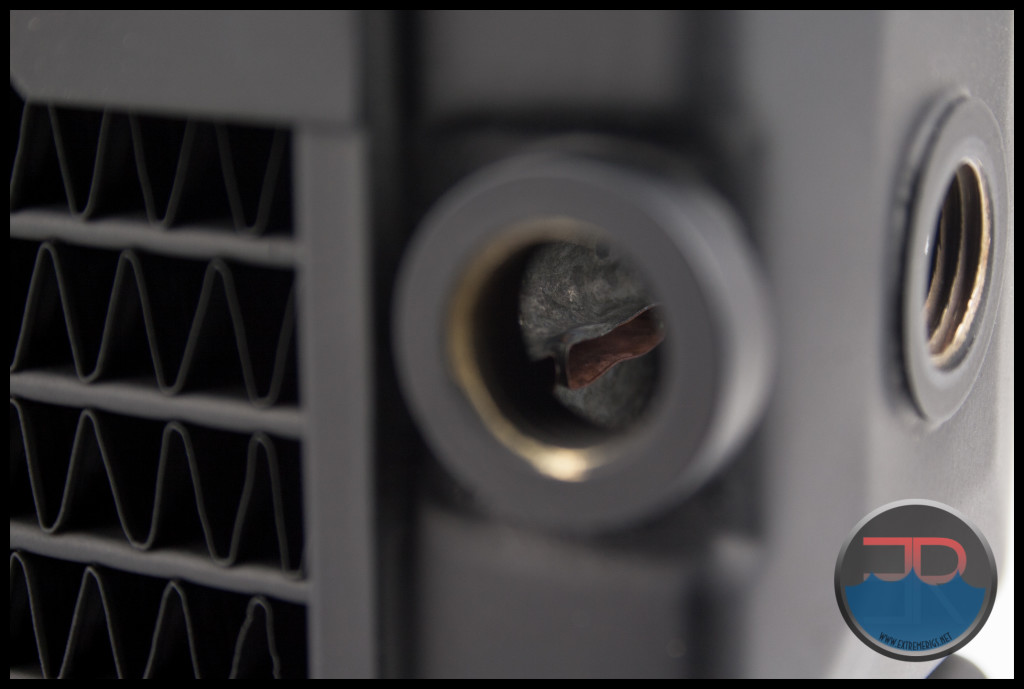
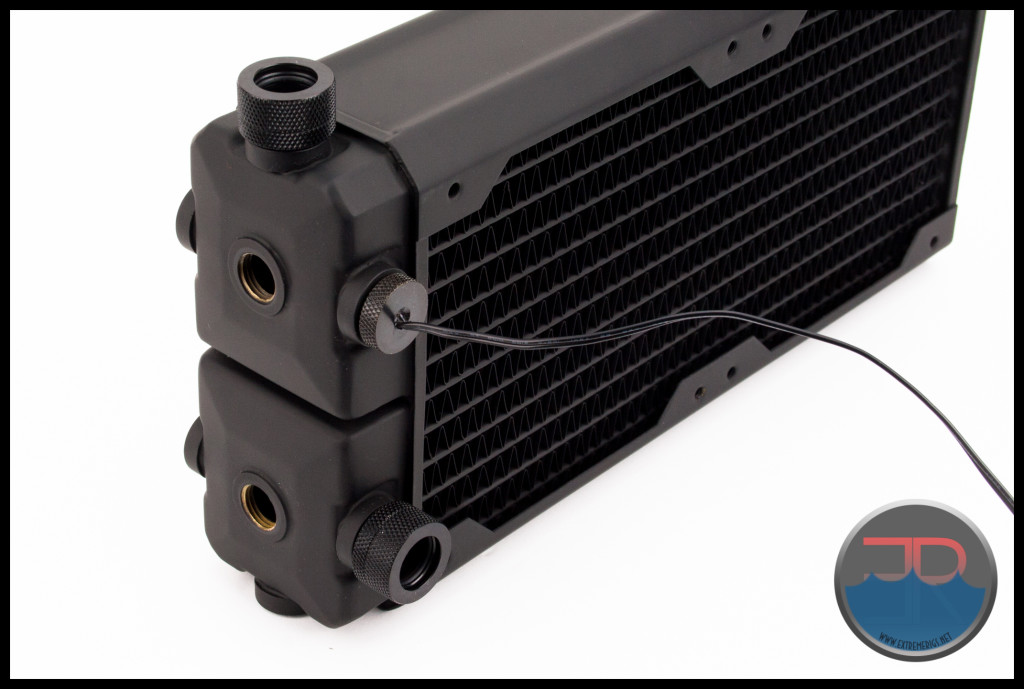
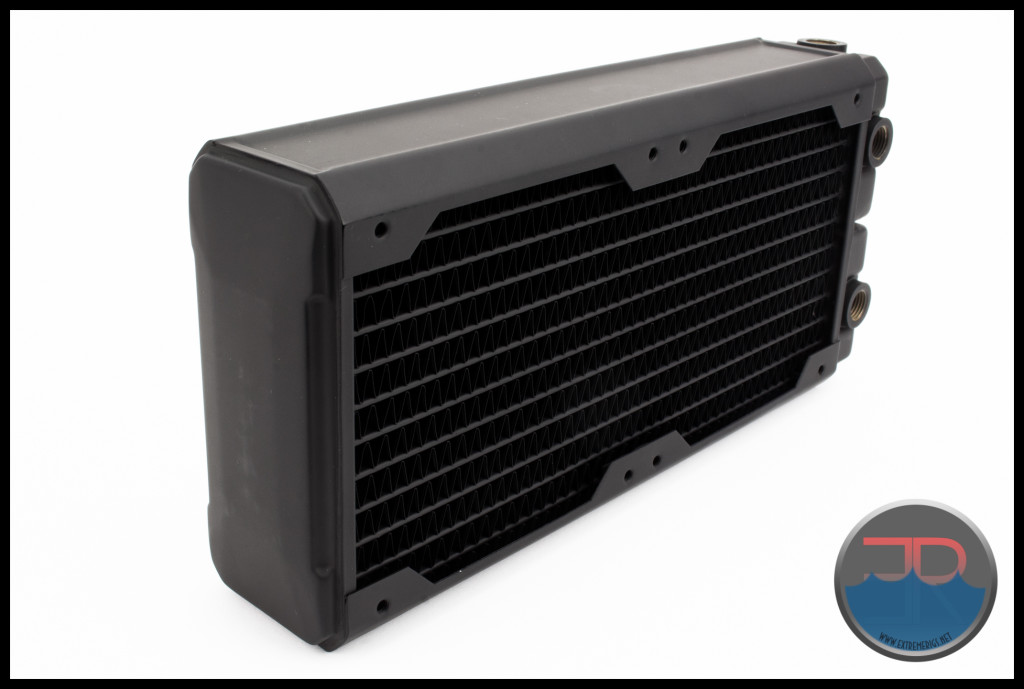
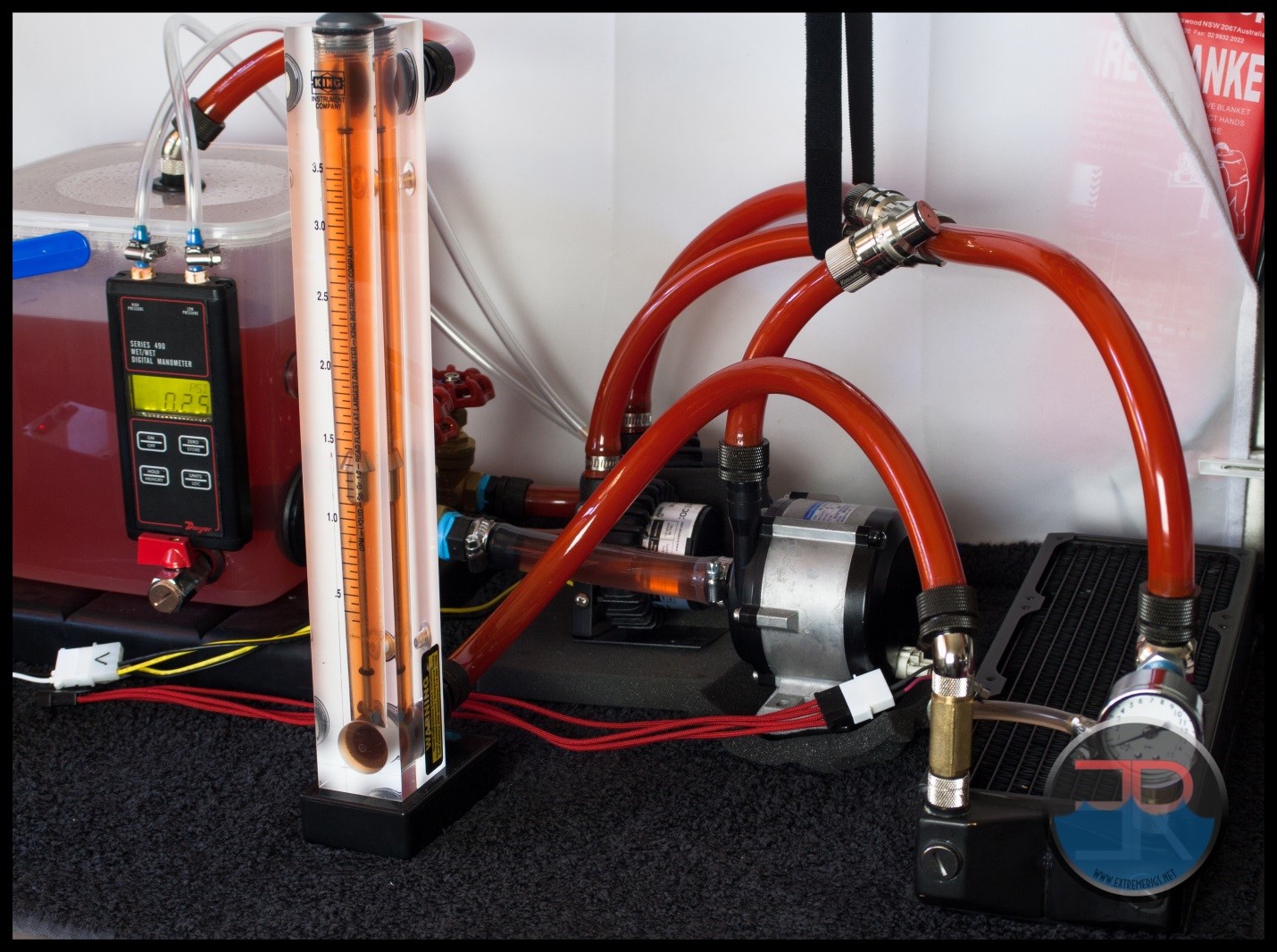


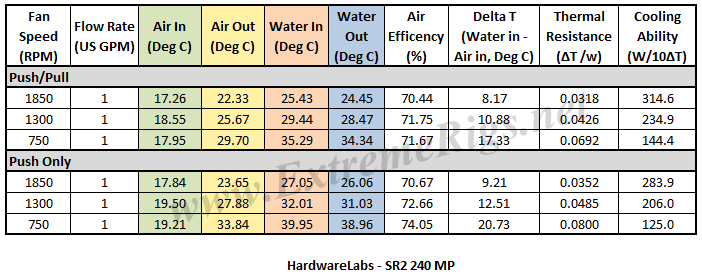


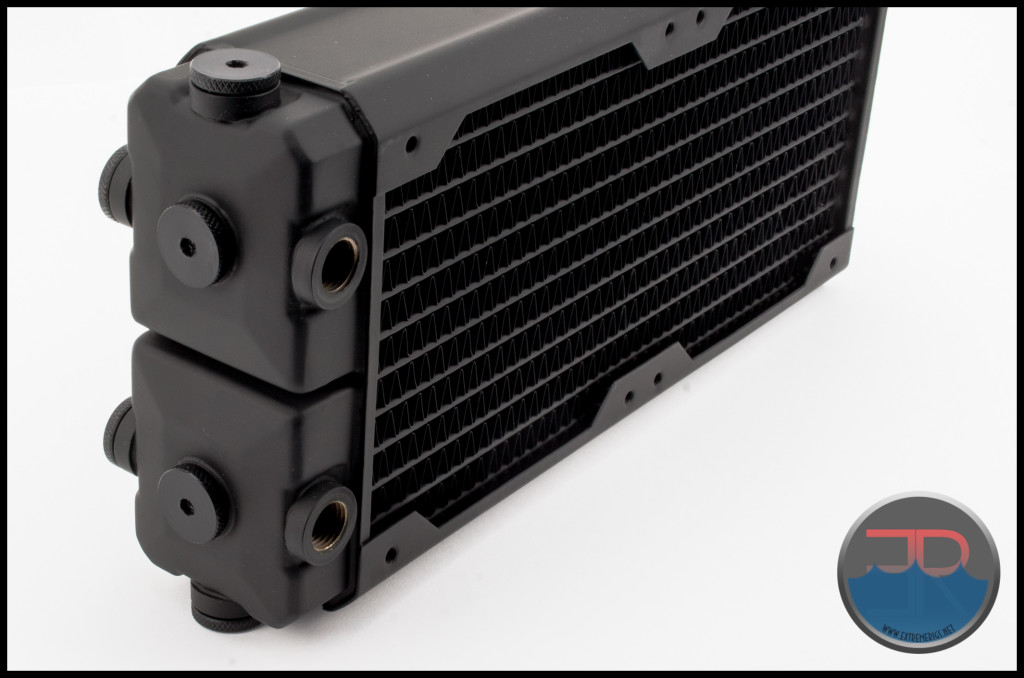

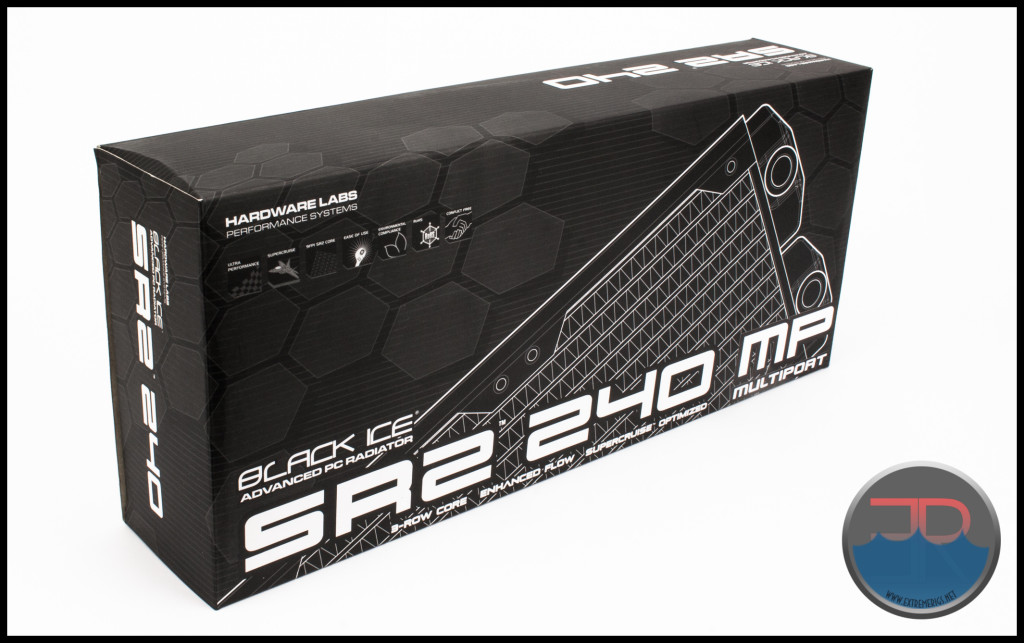
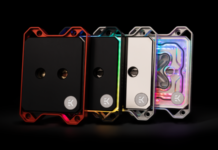
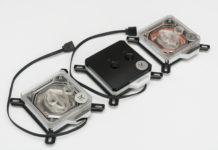
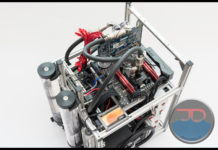

Maybe slightly disappointing thermal results, but not a deal breaker. Swarf in rad not a deal breaker either. Flexibility of ports, flexibility of use/fan rpms and overall quality mean that this is still a very good radiator. Again: great test. Now, please get more 240 results!
Often written or said in radiator reviews, “Since the XXX size of brand X radiator has shown XYZ level of performance, one should expect like performance from up-size XXX (or) down size XXX.” If the ratio of/comparable performance of the SR2 240 MP falls short of the SR2 360 MP, should we expect the 480 to provide an additional boost in performance over the 360 or similar performance to the 360? Given what the test results of the 240 tell us, how can an answer to either possibility be justified?
Not sure quite what you’re trying to say Questors – can you explain again?
The 240 performs at about 70% of a 360 when using an equal heatload. However it is running more efficiently as an equal heatload equates to a higher delta T. The 240 *should* of course be 66% of the the 360 and I do believe that it would give us that result if we kept a constant delta T instead of a constant heatload.
So to answer the question – should the 480 provide an additional performance boost over the 360? Absolutely – yes it should. As to how much – we would expect the ideal 33% more cooling ability when measuring a constant delta T, however for a constant heatload you would some efficiency because the delta T would be lower. So to guess – somewhere between 25-30% better cooling.
Does that answer the question?
This was the basis for me asking the question: “However, the thermal Test conditions did not favor the 240mm variant quite as well as the 360mm. The consistency was still there but performance was weaker when compared to the same competitor.”
To me this meant the performance of the SR 240 vs the XE 240 was less proportionate to the SR2 360 results against the XE 360.
Your response clears things up for me – “a constant delta T instead of a constant heatload”
[…] EK XE 240 Radiator Hardware Labs SR2 240 Radiator […]
Comments are closed.